Quiet Valley Living
Historical Farm
1000 Turkey Hill Rd.
Stroudsburg, PA 18360
1-570-992-6161
August 17 , 2007
While we were staying in Stroudsburg, PA I looked
around for places to visit. One of the things that came up was the Quiet Valley
Living Historical Farm. One of our favorite places to visit are what we call
Living History Museums. (Museums that have costumed docents or presenters.)
Oftentimes the docents are only available on the weekends, as many of these
folks are volunteers. Keeping this in mind we decided to pay a visit to Quiet
Valley on a Friday. We checked the weather and it was "supposed" to be
sunny all day. Oh well, you know what they say about the weather. It did hold
off raining until we had seen most of the farm. A very interesting point is that
instead of having historic buildings that had been moved into the area for
preservation these buildings were the original buildings that were there in the
1700's when the family settled there. As we first entered the property we
encountered a gate that had a counter-balance box-of-rocks to help you open the
gate.
we were staying in Stroudsburg, PA I looked
around for places to visit. One of the things that came up was the Quiet Valley
Living Historical Farm. One of our favorite places to visit are what we call
Living History Museums. (Museums that have costumed docents or presenters.)
Oftentimes the docents are only available on the weekends, as many of these
folks are volunteers. Keeping this in mind we decided to pay a visit to Quiet
Valley on a Friday. We checked the weather and it was "supposed" to be
sunny all day. Oh well, you know what they say about the weather. It did hold
off raining until we had seen most of the farm. A very interesting point is that
instead of having historic buildings that had been moved into the area for
preservation these buildings were the original buildings that were there in the
1700's when the family settled there. As we first entered the property we
encountered a gate that had a counter-balance box-of-rocks to help you open the
gate. 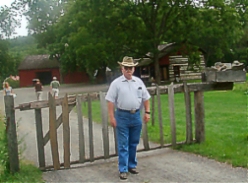
As we bought our tickets they explained to us that the docents would speak to us
in the "1st person", that is they would be talking as though they were
actually in that time period. They would certainly answer our questions but not
if it included something about modern things.
Our first docent explained the history of Quiet Valley to us. It seems
that the history of Quiet Village Living Historical Farm begins early 1760's when the Depper family left their home in the Palatinate region of Germany to start a new life in America. They sailed from Rotterdam to Philadelphia,
arriving in 1765, and eventually made their way north looking for land that they could farm. They settled in Quiet Valley near modern Stroudsburg, Pennsylvania. In 1780 their daughter Katherine married Johann Ludwig Meyer who had originally come to
America as a Hessian soldier during the Revolutionary War. Jolxann and Katherine passed the farm on to their son, a carpenter/farmer named John Simon Meyer. John Simon Meyer's daughter and son-in-law, Hannnh and Peter Marsh received the farm next. They sold the farm to their son Horace who lived on the farm until 1913 when the farm was sold outside the
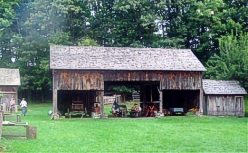 family.
After several years it passed to the non-profit organization that runs it today.
One of the interesting parts of the story was about one of the sons who went to
"the big city" to find himself a bride. Well, in the city she had the
luxury of having a cast-iron stove to cook on. When she arrived at the farm and
found a kitchen with an open fire for cooking she was less than happy about the
arrangement. She put up with this situation through two children and finally
told her husband she had had it and was going back to the "big city"
to live with her Ma. Fortunately her Ma was a very wise woman and instead of
letting her daughter move back in with her, with two children, she listened to
her complaints and sent her a new stove instead. This seemed to satisfy the
daughter, but then she set about modernizing a number of things around the farm,
which included fixing up the outside of the house and getting a pump organ in
the parlor to entertain family and friends.
family.
After several years it passed to the non-profit organization that runs it today.
One of the interesting parts of the story was about one of the sons who went to
"the big city" to find himself a bride. Well, in the city she had the
luxury of having a cast-iron stove to cook on. When she arrived at the farm and
found a kitchen with an open fire for cooking she was less than happy about the
arrangement. She put up with this situation through two children and finally
told her husband she had had it and was going back to the "big city"
to live with her Ma. Fortunately her Ma was a very wise woman and instead of
letting her daughter move back in with her, with two children, she listened to
her complaints and sent her a new stove instead. This seemed to satisfy the
daughter, but then she set about modernizing a number of things around the farm,
which included fixing up the outside of the house and getting a pump organ in
the parlor to entertain family and friends.
After our orientation we next went to the Farm House. We were able to go around
the back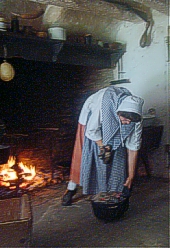 and into the "original" 1820 kitchen where Sarah Maude was
cooking Blueberry buckle in a Dutch Oven. The Dutch Oven was an interesting
design that allowed you to cook cakes or baked goods over an open fire, but
there was a concave lid that went on top that you could put hot coals in to cook
both the bottom and top at the same time. This was necessary since they didn't
have any kind of oven in the fireplace. She showed us an interesting plate made
out of wood. It was hollowed out on the top, with a smaller area where you could
put salt or other seasonings. She explained that in order to get the children to
eat the food on their plates, they were told that in order to have dessert they
had to eat everything. Then the plate was turned over and the dessert was served
on the bottom of the plate.
and into the "original" 1820 kitchen where Sarah Maude was
cooking Blueberry buckle in a Dutch Oven. The Dutch Oven was an interesting
design that allowed you to cook cakes or baked goods over an open fire, but
there was a concave lid that went on top that you could put hot coals in to cook
both the bottom and top at the same time. This was necessary since they didn't
have any kind of oven in the fireplace. She showed us an interesting plate made
out of wood. It was hollowed out on the top, with a smaller area where you could
put salt or other seasonings. She explained that in order to get the children to
eat the food on their plates, they were told that in order to have dessert they
had to eat everything. Then the plate was turned over and the dessert was served
on the bottom of the plate.
From the kitchen we went upstairs to the bedroom where Elizabeth showed us the
area where she, her parents, and her siblings slept. It was interesting hearing
how her Pa her Ma and the 1 year old brother would all sleep in the large bed.
The youngest baby would sleep in the cradle right next to the bed so Ma could
just reach out and rock the baby if he got restless during the night. As long as
the children were short enough they would sleep in the trundle bed that was
pulled out from under the parents' large bed. However, in the winter Pa would
wait until the "young'uns" got into the trundle bed and then push them
underneath the bed. After that he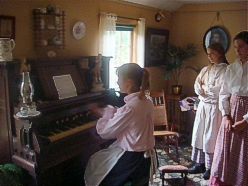 would close the curtains around the bed to
keep everyone snug and warm. Of course, having young children I can imagine when
someone had to go to the potty at night, Pa had to get up out of his warm bed
and pull the trundle out. At first, they had to trudge out to the out house.
However, they finally got a Potty Chair that they could use inside the house at
night. Elizabeth explained that whichever of the children was bad during the day
had to empty the slop bucket in the morning. She then proceeded to explain how
each girl would start her dowry at the tender age of 5 or 6. She would put
things in it, like quilts, cherry pit bags (used to heat the beds at night),
etc. The Pa would have to make a dower chest to store all these things in.
would close the curtains around the bed to
keep everyone snug and warm. Of course, having young children I can imagine when
someone had to go to the potty at night, Pa had to get up out of his warm bed
and pull the trundle out. At first, they had to trudge out to the out house.
However, they finally got a Potty Chair that they could use inside the house at
night. Elizabeth explained that whichever of the children was bad during the day
had to empty the slop bucket in the morning. She then proceeded to explain how
each girl would start her dowry at the tender age of 5 or 6. She would put
things in it, like quilts, cherry pit bags (used to heat the beds at night),
etc. The Pa would have to make a dower chest to store all these things in.  When
the young lady was old enough to be courted the young man would come to the
house and look in her dower chest. If it was full he knew that she was a hard
worker and would offer to marry her. If it was only half-full he might take one
look and walk right out the door. Maybe we need to restart that tradition?
When
the young lady was old enough to be courted the young man would come to the
house and look in her dower chest. If it was full he knew that she was a hard
worker and would offer to marry her. If it was only half-full he might take one
look and walk right out the door. Maybe we need to restart that tradition?
After we left the bedroom we went into the parlor (which moved us up to 1892).
One of the men in our group forgot that someone had told us what the year was
and asked one of the young ladies what year it was. Miss Smith looked at him and
said "Sir, I believe you might want to get yourself a calendar so you can
remember what year you are in." It was said with such a gleam in her eye
that the man just chuckled. Anna, one of the other young ladies in the parlor
explained how her cousin, Miss Smith, was just visiting. Miss Smith then
proceeded to demonstrate how to play the pump organ. She entertained us with a
version of Amazing Grace and had everyone in the group singing along. 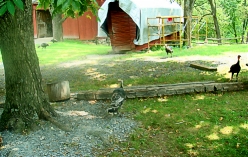
We then moved to the "new" kitchen. The main point of interest was, of
course, the beautiful cast iron stove. She asked everyone how much they thought
the lady of the house paid for the stove. Well, guesses ranged from $500 down.
It turned out that the lady paid $25 for the stove in 1892. (Wow, what a
bargain). She then showed us a "mini-stove" sitting on the top of the
large stove. She explained that this was used in the summer when cooking indoors
would be too hot.
We then proceeded outdoors where they had all of the livestock running around
that they would have had on any working farm. I thought the turkeys were
interesting. They started  calling them to feed them and I got caught in a turkey
stampede. Sheesh! did you ever get run over by a stampeding turkey herd? Not a
pleasant experience. I kept telling myself that Thanksgiving was coming.
calling them to feed them and I got caught in a turkey
stampede. Sheesh! did you ever get run over by a stampeding turkey herd? Not a
pleasant experience. I kept telling myself that Thanksgiving was coming.
When we went over to the one barn area we saw one of the young men rolling
tobacco leaves for cigars. He explained that he had just come to the farm and
this was his first attempt.
In other barns they had various machines that were used for chores needed around
the farm.
There are other buildings around the property, but unfortunately it started to
rain and we decided to head for the car.
We enjoyed seeing the old buildings and property, but it was the lively docents
that really made our day. I would certainly recommend a tour of Quiet Valley if
you are in the area.
Good Luck! Have Fun! and Stay Safe!
Laura